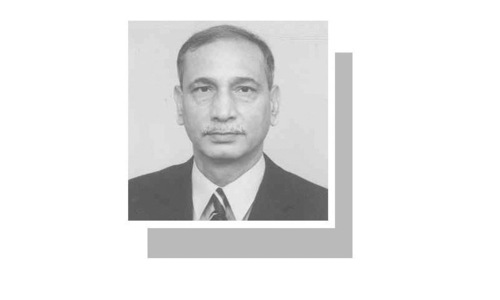KARACHI, June 16: Perhaps the argument that one man’s terrorist is another man’s freedom fighter is best exemplified – specifically in Sindh’s context – by the personality and life-story of the enigmatic Sibghatullah Shah Rashdi, the sixth Pir Pagara, reverentially called Surya Badshah by his followers.
This was the impression one was left with after a detailed lecture on the Hur movement, specifically focussing on the turbulent life and equally tumultuous death of Pir Sibghatullah Shah, which was delivered by former IG Sindh Aftab Nabi on Monday at the Pakistan Institute of International Affairs (PIIA).
On the occasion Khadim Hussain Soomro, author of Freedom at the Gallows, which is based on Sibghatullah Shah’s life (from hereon referred to as Pir Pagara) handed over compact disc copies of the Lambrick Papers on the Hur movement, originally kept in the British Library in London, to the PIIA library.
The CDs have condensed the data of 79 files that record details of the Hur movement from 1893 till 1947. Mr Nabi, who based his presentation on the above data, said he had researched the Hur movement from the law and order angle. He started off his lengthy lecture chronologically, discussing the uprisings against the British colonialists of Pir Pagara’s ancestors, the earlier Pirs.
He said that at a certain point in time, the hereditary spiritual family split into two groups: the Jhandhara group based in Hala and the Pagara group based in Pir-Jo-Goth.
“The British, through repressive legislation, labelled the Hurs a ‘criminal tribe.’ This was a common practice that existed throughout India. The British labelled numerous tribes ‘criminal’ for not toeing their line. However, the Hur rebellion was crushed with an iron hand,” said Mr Nabi.
He said the first anti-British insurgency was of Bachu Badshah and Peeru Wazir. Peeru had challenged British dominance and fell in a fight to the death with the colonialists. Thereafter the Criminal Tribes Act was passed. This draconian law forced the Hurs to remain in concentration camp-like settlements where the men could go out and work in the fields, but the women and children were forbidden to leave. “The conditions were horrible. They were denied even the most basic of necessities,” Aftab Nabi said.
Moving to 1930 and Pir Sibghatullah Shah’s period, he said the Pir was fiercely independent and therefore was watched like a hawk by the CID. A case was initiated against him after some maids, who had escaped from his palace, complained of maltreatment at the Pir’s hands, while the authorities recorded the statement of a boy called Ibrahim – another servant of the Pir’s – who was reportedly locked up in a wooden box as a punishment.
In retaliation, the administration cancelled the Pir’s arms licences, to which Quaid-i-Azam Mohammad Ali Jinnah protested. A case was lodged, the Pir was sentenced and shipped off to prison in Bengal for six years.
Mr Nabi said that in the 1936 elections, many parties courted Pir Pagara due to the sizable Hur vote. However, trouble was brewing for the Pir as there were reports of him raising a force of Ghazis and seeking to become king of Sindh. Also, the Nazim of Khairpur state – Syed Ghulam Rasool Shah, who was a mortal enemy of the Pir – and other influentials played up the threat of the Pir’s ambitions. The fact that Pir Pagara had pro-Congress leanings also did not win him many friends within the British establishment in India.
“However, during the ‘Hur outrages,’ perceived collaborators, especially policemen, railways and canal employees, were targeted. The Hurs would hack to death their enemies,” he added.
Pir Pagara was again shipped off to jail, this time to Nagpur. As a reprisal, the Hurs attacked Ghulam Rasool Shah, decapitated him and hacked him to death. The British were now at their wit’s end and a secret session of the Sindh Assembly was summoned, where the Anti-Hur Act was passed. This act defined who could be called a Hur and contained even more repressive clauses: anyone found giving food, water or shelter to a Hur would be considered a criminal. Thousands suffered and Hur defiance intensified, Mr Nabi said.
For the British colonizers, the derailment of the Lahore Mail and massacre of its passengers in 1942 came as the last straw. An extremely severe martial law was imposed while a sham trial was initiated against the Pir.
“All his enemies testified against him, including his own brother Rahim Shah. A partition was set up so that the Pir and the witnesses could not make eye contact, as it was said Pagara had a hypnotic gaze. The Pir wanted the Quaid to defend him, but that could not materialize,” said Aftab Nabi. The Pir, who assumed his role at 14, was hanged at the age of 33 in 1943.
To ensure Sibghatullah Shah would not influence his followers from beyond the grave, Mr Nabi said the British buried him secretly on Astola Island, 40km off the coast of Balochistan. The island, part of the Khan of Kalat’s territory, was said to be infested with scorpions and snakes.
When Rahim Hingoro – the last of the Hur commanders – surrendered, it spelt the end of the insurgency.
The CDs are available at the PIIA library for those interested.














































Dear visitor, the comments section is undergoing an overhaul and will return soon.